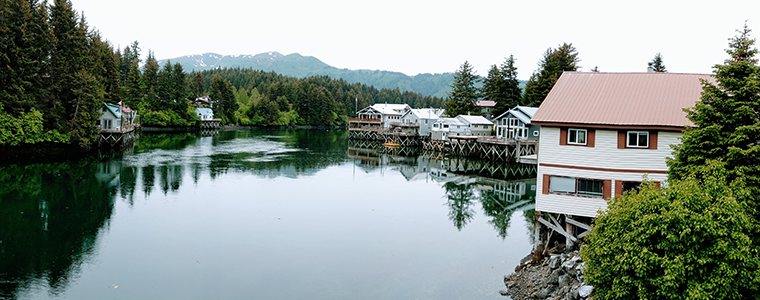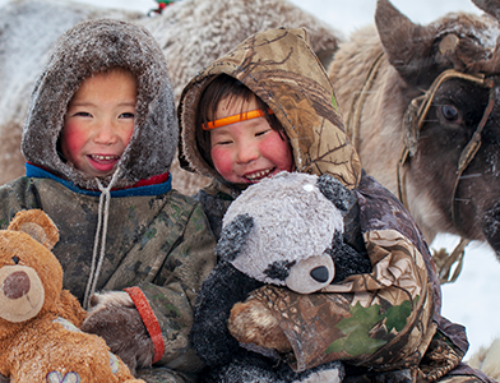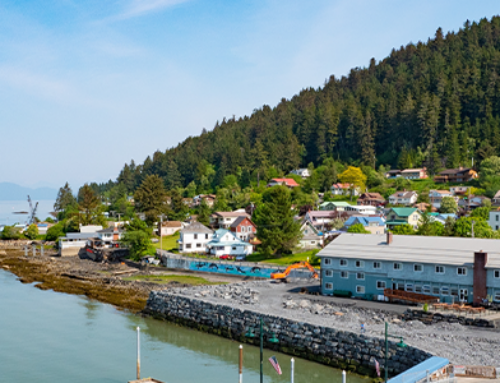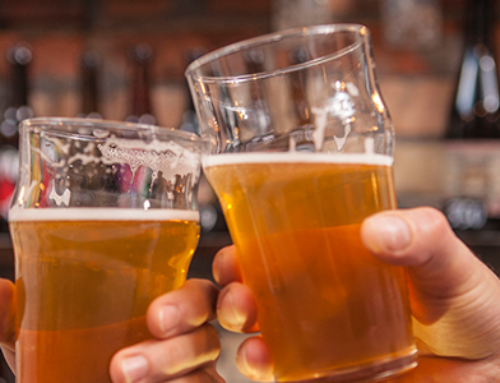You may know Alaska as the 49th state, as the Last Frontier, as a place of unspoiled wilderness, abundant wildlife, brutal winters, and incredible natural beauty.
However, we suspect there are still a few things you probably don’t know about Alaska. Check out this list of lesser-known facts about the Land of the Midnight Sun—and see how much you really know about Alaska.
#1: The U.S. Wrote a Check to Purchase Alaska (And We Still Have a Copy of It!)
In 1867, the U.S. ratified an agreement with Russia to purchase Alaska for the price of $7.2 million. Using the average inflation rate of the U.S. dollar, that would translate to about $142 million today.
And how, exactly, did the U.S. deliver its payment? They simply wrote a check, as you can see above. The check was made out to Eduard de Stoekl, the Russian minister who negotiated the deal on Russia’s behalf. Today, the check has its own place in the National Archives in Washington D.C., along with the Declaration of Independence, the Constitution, and the Bill of Rights.
#2: Alaska Is a Land of Volcanoes
Of all the volcano eruptions in the U.S. over last 200 years, more than 75% have occurred in Alaska. (!)
The U.S. Geological Survey has identified more than 130 volcanoes and volcanic fields active in Alaska over the last two million years. However, only about 90 of those have been active in the last 10,000 years. Of those, only 50 have been active since about 1760.
Before you write Alaska off as a nightmarish volcanic landscape, you should know this: Most of Alaska’s volcanic activity occurs along the Aleutian Arc, that curved tail of islands extending from the Southwest corner of Alaska. This Alaska Volcano map from the Alaska Volcano Observatory will show you exactly what we mean—and where you’ll find all of Alaska’s volcanoes. It’ll give you a much better sense of where all the recent activity has been—just in case you’re concerned!
#3: The Third-Longest River in the U.S. Runs Through Alaska
Given Alaska’s size, this one might not be as surprising, but it’s still impressive!
Just behind the Missouri and the Mississippi Rivers, the longest and second-longest rivers in the U.S., you’ll find the Yukon River, the third-longest river in the U.S., at 1,982 miles long. The Yukon starts in British Columbia, Canada, flows through the Yukon Territory, then crosses Alaska to empty in the Bering Sea.
The Yukon River has played a significant role in the state’s development, and it remains important today. The Yukon was once a major means of transportation through the state, especially during gold rush times. It’s also a giant breeding ground for Chinook salmon and an important source of food for Indigenous fishers. The Yukon is also a canoeing destination, where you can choose your own adventure. Paddle for a few hours, a few miles, or a few days.
#4: Alaska Is Also Home to the Third-Largest Lake in the U.S. (with Its Own Mythical Monster!)
At 77 miles long and 22 miles wide, Lake Iliamna is an impressive one—the third-largest lake located entirely within the U.S. In fact, Lake Iliamna covers 1,012 square miles. To give you some perspective, the state of Rhode Island takes up 1,545 square miles, so Like Iliamna would cover two-thirds of the state.
However, the most interesting thing about Lake Iliamna may not be its size but the mythical monster purported to exist in its depths. “Ilie” as the creature is known, is reported to have a shark-like body and a penchant for destroying fishing gear. Although the Anchorage Daily News offered $100,000 for proof of the creature’s existence, no one was able to capture anything definitive enough to claim the reward. Still, the rumors persist . . .
#5: Alaska’s Flag Was Designed by a Teenager
In 1927, the Seward Gateway Newspaper announced a competition to design a flag for Alaska, then a U.S. territory. The contest was sponsored by the American Legion and open to 7th-to-12th-grade students in all of the territory’s schools.
14-year-old Benny Benson created the winning design. At the time of the contest, Benson was living in an orphanage in Seward. Although he was initially believed to be Sugpiaq, or Alutiiq, research revealed that his mother had been born and raised in Unalaska, and Benson was of Unangax heritage.
Benson won a $1,000 scholarship and a watch in recognition of his design. The flag he created is still in use today as the Alaska state flag.
In Benson’s words:
“The blue field is for the Alaska sky and the forget-me-not, an Alaska flower. The North Star is for the future of the state of Alaska, the most northerly in the Union. The dipper is for the Great Bear – symbolizing strength [sic].”
#6: The State’s Slogan Was Also Decided by a Contest
To celebrate the centennial of Alaska’s purchase, the Alaska Centennial Commission held a contest to choose a state motto.
The winner? “North to the Future.” The motto was created by a Juneau-based journalist named Richard Peter. Peter penned the motto as a nod to the promise of Alaska’s future.
#7: The Japanese Invaded Alaska During World War II
The only land battle fought on U.S. soil during World War II happened in Alaska. Following air strikes on Dutch Harbor from June 3-4, 1942, the Japanese landed on and seized the islands of Attu and Kiska in Alaska’s Aleutian Islands. The residents of Attu village were taken prisoner by the Japanese and transported back to Hokkaido, where they were held for the entirety of the war. It wasn’t until the Battle of Attu—codename Operation Landcrab—in May 1943 that the Japanese were defeated and the islands recaptured.
#8: You’ll Meet a Ton of Pilots in Alaska
In Alaska, you’ll find 9,127 active pilots, which is a little more than 1% of the population. That’s also six times as many pilots per capita than anywhere else in the U.S. When you consider the fact that airplanes are vital for accessing so many of Alaska’s communities, it just makes sense. The state relies on pilots to deliver essentials, like groceries and supplies, as well as transport patients for medical care.
In other words, if you’re a pilot or an aspiring pilot, you’ll find plenty of fellow pilots in the state—and plenty to keep you busy!
#9: You’ll Also Meet a Diverse Native Alaskan Population
The first human settlers likely arrived in Alaska around 14,000 years ago. Today, 19.6% of the state’s population identifies as American Indian or Alaska Native, the highest of any state.
You’ll find eleven distinct cultures in Alaska:
- The Eyak, Tlingit, Haida, and Tsimshian peoples of Southeastern Alaska
- The Inupiaq and St. Lawrence Island Yupik of northern and Northwestern Alaska
- The Yup’ik and Cup’ik of southwest Alaska
- The Athabascan peoples in Alaska’s interior
- The Alutiiq (Sugpiaq) and Unangax peoples of south-central Alaska and the Aleutian Islands.
#10: There’s No Place Better for Huge Produce
A 138-pound cabbage. A 65-pound cantaloupe. An 83-pound rutabaga. A 39-pound turnip. Every one of these world-record pieces of produce was grown in Palmer, Alaska, right in the heart of the Matanuska Valley, a location famous for its gigantic fruits and vegetables.
What’s the secret? Those long, summer nights with as many as 20 hours of sunshine, plus some very careful cultivation.
#11: Dog Mushing Is Big in Alaska
In fact, it’s the official state sport. It was given that honor in 1972, although pulling dogs with sleds is something that Alaska residents have been doing for hundreds of years.
In addition to giving the sport the official nod, the state also honored the Alaskan malamute as its state dog. Malamutes are the most common breed of sled dog, although Siberian huskies, Samoyeds, and Chinook are also often called into service to pull sleds.
Malamutes have the children of Polaris K-12 School in Anchorage to thank for their designation. After letters, phone calls, a website, fundraisers, and even an op-ed in the Anchorage Daily News, the students were rewarded with the passage of their bill, HB14, which declared the Alaskan malamute the state dog.
#12: Alaska Has Its Own North Pole
While the geographic North Pole—i.e., the northernmost point on the globe—is in the Arctic Ocean, you’ll also find a North Pole in Alaska. In fact, you can drive right to it in less than 20 minutes!
In North Pole, Alaska, population 2,969, “the spirit of Christmas lives year-round.” The town’s most distinctive landmark is the Santa Claus House, open all year to enjoy Christmas ornaments, an on-duty Santa, and general merriment.
By the way, if you drop a letter in the mail addressed to “Santa Claus, North Pole, Alaska,” your letter will end up in this very town. A team of volunteers answers hundreds of thousands of such letters each year.
#13: Alaska’s Biggest Export Isn’t Oil
Given the state’s significant oil and gas industry, you might expect petroleum to be the top Alaska export.
However, zinc was the state’s top export in 2021. In fact, Alaska’s zinc exports were worth double the next-highest export, petroleum oil. Gold and lead were just behind petroleum. They were followed by—you probably guessed it!—seafood. In fact, the majority of the salmon, crab, halibut, and herring consumed in the U.S. comes from Alaska.
#14: There’s Just Something About Washington
Finally, we know Alaska isn’t for everybody. So when Alaska residents move to another state, where do they go? From 2019-2020, the answer was Washington (state, not D.C.)!
Strangely enough, when you examine the reverse direction, the opposite is also true!
Alaska saw the highest inflow of from Washington, as well. (California and Texas were right behind!)
Maybe it’s the proximity. Maybe it’s a cultivated tolerance for cold winters. Whatever the reason, Washington remains a top origin and destination for people leaving and entering Alaska.
How Well Do You Know Alaska?
Did all 14 of our facts surprise you? Or did you discover that you’re already an Alaska expert?
If you’re considering a move to Alaska, learning everything you can about the Last Frontier will help you decide whether relocating is right for you. It will also help you set your expectations, so you can make an easy transition to your new home.
Once you’re here, we promise you’ll discover even more surprising things about Alaska’s gorgeous landscapes and its diverse and unique people—things you can really only learn by moving to Alaska.
Need some help moving your belongings to Alaska? Our Anchorage-based team handles moves all over the state, even to remote areas. Just reach out for a complimentary quote to get started.
Tell us about your move!
 (907) 868-4756
(907) 868-4756


